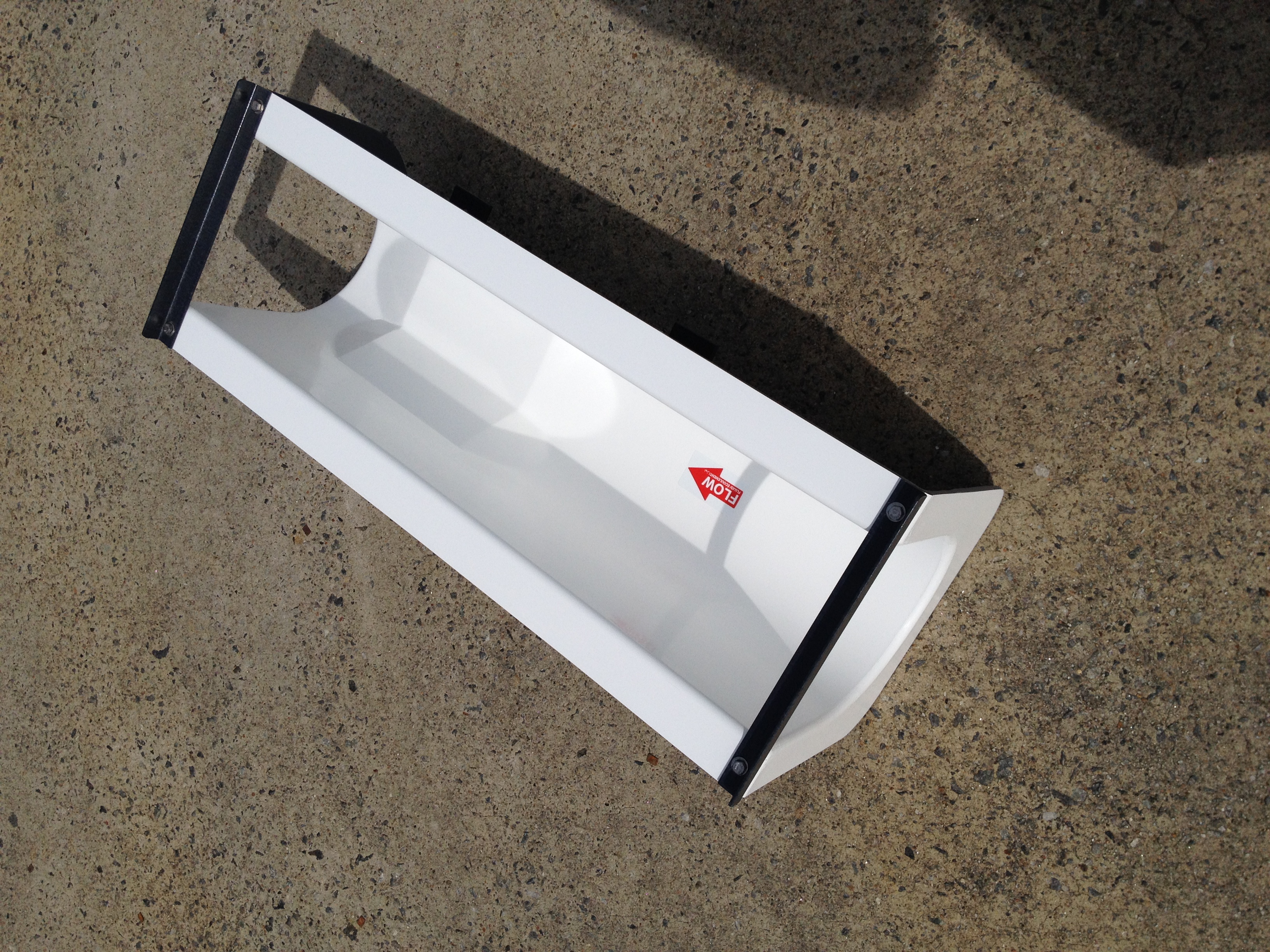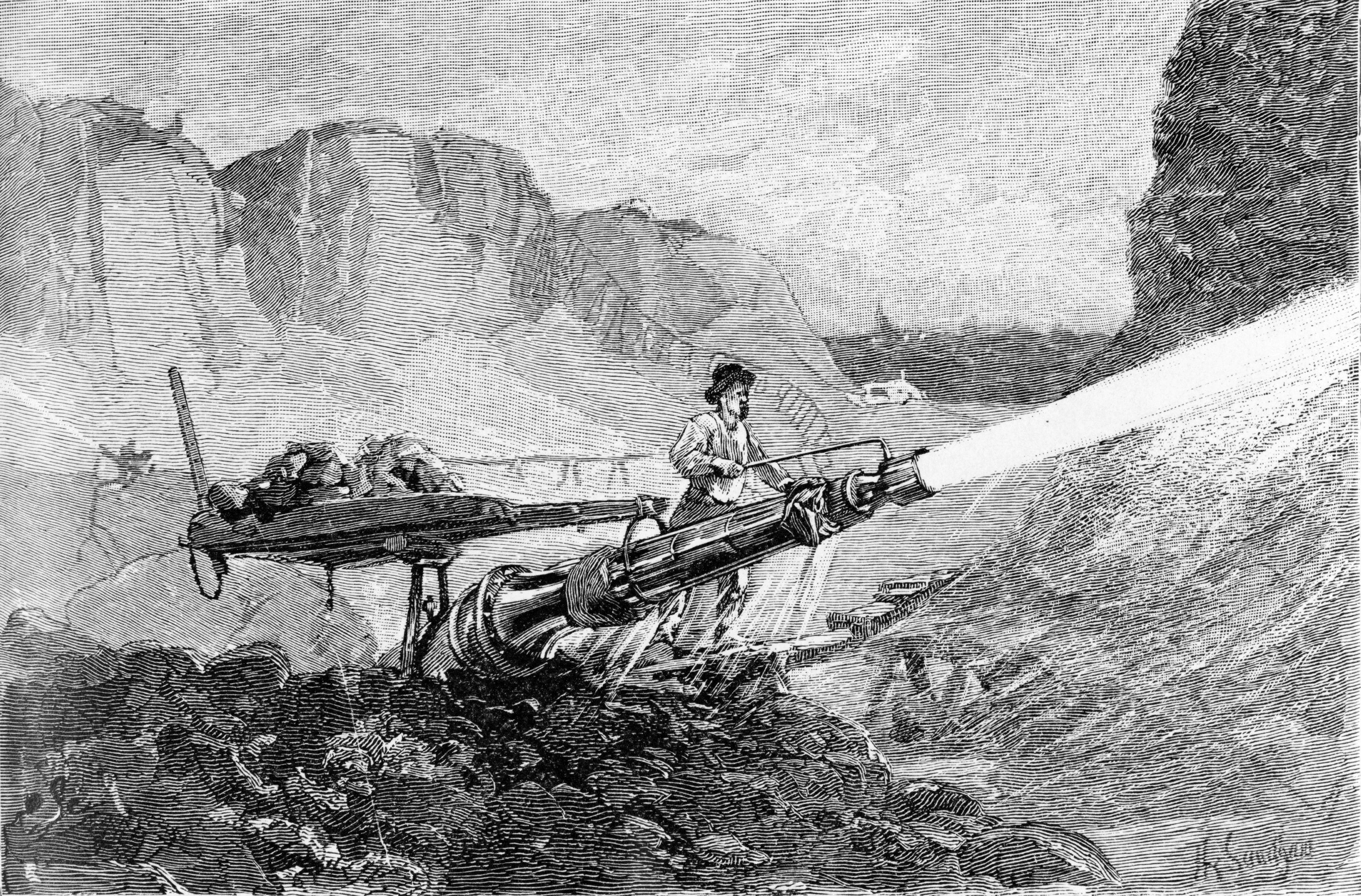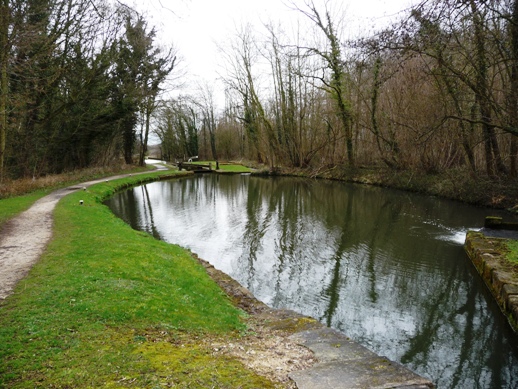|
Flume
A flume is a human-made channel for water, in the form of an open declined gravity chute whose walls are raised above the surrounding terrain, in contrast to a trench or ditch. Flumes are not to be confused with aqueducts, which are built to transport water, rather than transporting materials using flowing water as a flume does. Flumes route water from a diversion dam or weir to a desired materiel collection location. Flumes are usually made up of wood, metal or concrete. Many flumes took the form of wooden troughs elevated on trestles, often following the natural contours of the land. Originating as a part of a mill race, they were later used in the transportation of logs in the logging industry, known as a log flume. They were also extensively used in hydraulic mining and working placer deposits for gold, tin and other heavy minerals. Etymology The term ''flume'' comes from the Old French word ''flum'', from the Latin ''flumen'', meaning a river. It was formerly used for a ... [...More Info...] [...Related Items...] OR: [Wikipedia] [Google] [Baidu] |
Log Flume
A log flume is a watertight flume constructed to transport lumber and logs down mountainous terrain using flowing water. Flumes replaced horse- or oxen-drawn carriages on dangerous mountain trails in the late 19th century. Logging operations preferred flumes whenever a reliable source of water was available. Flumes were cheaper to build and operate than logging railroads. They could span long distances across chasms with more lightweight trestles. Flumes remained in widespread use through the early 20th century. The logging truck replaced both the logging railroad and the flume after WWII. Today, log flumes remain in the popular imagination as amusement park rides. History J.W. Haines built the first successful lumber flume in 1859. The v-shaped trough brought a half-million feet of lumber daily from the eastern Sierra Nevada to the Comstock Lode. The route was between Lake Tahoe and Reno, terminating at the Virginia and Truckee Railroad terminus in Washoe Valley. Soo ... [...More Info...] [...Related Items...] OR: [Wikipedia] [Google] [Baidu] |
Parshall Flume
The Parshall flume is an open channel flow metering device that was developed to measure the flow of surface waters and irrigation flows. The Parshall flume is a fixed hydraulic structure. It is used to measure volumetric flow rate in industrial discharges, municipal sewer lines, and influent/effluent flows in wastewater treatment plants. The Parshall flume accelerates flow through a contraction of both the parallel sidewalls and a drop in the floor at the flume throat. Under free-flow conditions the depth of water at specified location upstream of the flume throat can be converted to a rate of flow. Some states specify the use of Parshall flumes, by law, for certain situations (commonly water rights). The design of the Parshall flume is standardized under ASTM D1941, ISO 9826:1992, and JIS B7553-1993. The flumes are not patented and the discharge tables are not copyright protected. A total of 22 standard sizes of Parshall flumes have been developed, covering flow ranges from 0. ... [...More Info...] [...Related Items...] OR: [Wikipedia] [Google] [Baidu] |
Flume Little Sandy River
A flume is a human-made channel for water, in the form of an open declined gravity chute whose walls are raised above the surrounding terrain, in contrast to a trench or ditch. Flumes are not to be confused with aqueducts, which are built to transport water, rather than transporting materials using flowing water as a flume does. Flumes route water from a diversion dam or weir to a desired materiel collection location. Flumes are usually made up of wood, metal or concrete. Many flumes took the form of wooden troughs elevated on trestles, often following the natural contours of the land. Originating as a part of a mill race, they were later used in the transportation of logs in the logging industry, known as a log flume. They were also extensively used in hydraulic mining and working placer deposits for gold, tin and other heavy minerals. Etymology The term ''flume'' comes from the Old French word ''flum'', from the Latin ''flumen'', meaning a river. It was formerly used for a ... [...More Info...] [...Related Items...] OR: [Wikipedia] [Google] [Baidu] |
Montana Flume
A Montana flume, is a popular modification of the standard Parshall flume. The Montana flume removes the throat and discharge sections of the Parshall flume, resulting a flume that is lighter in weight, shorter in length, and less costly to manufacture. Montana flumes are used to measure surface waters, irrigations flows, industrial discharges, and wastewater treatment plant flows. As a short-throated flume, the Montana flume has a single, specified point of measurement in the contracting section at which the level is measured. The Montana flume is described in US Bureau of Reclamation's Water Measurement Manual and two technical standards MT199127AG and MT199128AG by Montana State University. As a modification of the Parshall flume, the design of the Montana flume is standardized under ASTM D1941, ISO 9826:1992, and JIS B7553-1993. The flumes are not patented and the discharge tables are not copyright protected. A total of 22 standard sizes of Montana flumes have been developed ... [...More Info...] [...Related Items...] OR: [Wikipedia] [Google] [Baidu] |
Palmer-Bowlus Flume
The Palmer-Bowlus flume, is a class of flumes commonly used to measure the flow of wastewater in sewer pipes and conduits. The Palmer-Bowlus flume has a u-shaped cross-section and was designed to be inserted into, or in line with, pipes and u-channels found in sanitary sewer applications. As a long-throated flume, the point of measurement of the Palmer-Bowlus flume is anywhere upstream of the throat ramp greater than D/2 (D=flume size). Montana flume has a single, specified point of measurement in the contracting section at which the level is measured. Unlike most other flumes used for open channel flow measurement, the Palmer-Bowlus flume can be calibrated by theoretical analysis. The general design of the flume detailed in ASTM D5390: Standard Test Method for Open-Channel Flow Measurement of Water with Palmer-Bowlus Flumes. It is important to note that unlike the Parshall flume The Parshall flume is an open channel flow metering device that was developed to measure the flow ... [...More Info...] [...Related Items...] OR: [Wikipedia] [Google] [Baidu] |
Cutthroat Flume
The Cutthroat flume is a class of flow measurement flume developed during 1966/1967 that is used to measure the flow of surface waters, sewage flows, and industrial discharges. Like other flumes, the Cutthroat flume is a fixed hydraulic structure. Using vertical sidewalls throughout, the flume accelerates flow through a contraction of sidewalls until the flow reaches the "throat" of the flume, where the flow is then expanded. Unlike the Parshall flume, the Cutthroat flume lacks a parallel-walled throat section and maintains a flat floor throughout the flume. The design of the Cutthroat flume is standardized but not covered by a national or international standard (unlike the Parshall flume). The flumes are not patented and the discharge tables are not copyright protected. A total of 16 standard sizes of Cutthroat flumes have been developed, covering flow ranges from 0.3536 gpm .0223 L/sto 54,801 gpm ,458 L/s Free-flow equation Under free-flow conditions the depth of water ... [...More Info...] [...Related Items...] OR: [Wikipedia] [Google] [Baidu] |
Weir
A weir or low head dam is a barrier across the width of a river that alters the flow characteristics of water and usually results in a change in the height of the river level. Weirs are also used to control the flow of water for outlets of lakes, ponds, and reservoirs. There are many weir designs, but commonly water flows freely over the top of the weir crest before cascading down to a lower level. Etymology There is no single definition as to what constitutes a weir and one English dictionary simply defines a weir as a small dam, likely originating from Middle English ''were'', Old English ''wer'', derivative of root of ''werian,'' meaning "to defend, dam". Function Commonly, weirs are used to prevent flooding, measure water discharge, and help render rivers more navigable by boat. In some locations, the terms dam and weir are synonymous, but normally there is a clear distinction made between the structures. Usually, a dam is designed specifically to impound water beh ... [...More Info...] [...Related Items...] OR: [Wikipedia] [Google] [Baidu] |
Hydraulic Mining
Hydraulic mining is a form of mining that uses high-pressure jets of water to dislodge rock material or move sediment.Paul W. Thrush, ''A Dictionary of Mining, Mineral, and Related Terms'', US Bureau of Mines, 1968, p.560. In the placer mining of gold or tin, the resulting water-sediment slurry is directed through sluice boxes to remove the gold. It is also used in mining kaolin and coal. Hydraulic mining developed from ancient Roman techniques that used water to excavate soft underground deposits. Its modern form, using pressurized water jets produced by a nozzle called a "monitor", came about in the 1850s during the California Gold Rush in the United States. Though successful in extracting gold-rich minerals, the widespread use of the process resulted in extensive environmental damage, such as increased flooding and erosion, and sediment blocking waterways and covering farm fields. These problems led to its legal regulation. Hydraulic mining has been used in various forms ... [...More Info...] [...Related Items...] OR: [Wikipedia] [Google] [Baidu] |
Canal Pound
A canal pound (from impound), reach, or level (American usage), is the stretch of level water impounded between two canal locks. Canal pounds can vary in length from the non-existent, where two or more immediately adjacent locks form a lock staircase, to many kilometres/miles. The longest canal pound in the United Kingdom is between the stop lock on the Trent and Mersey Canal at Preston Brook (Dutton Stop Lock No 76) and the start of the Leeds and Liverpool Canal near Leigh (Poolstock Bottom Lock No 2), a distance of . Another long pound is on the Kennet and Avon Canal between Wootton Rivers Bottom Lock and Caen Hill top lock. The longest level on the Erie Canal in New York was the 60 mile level (actually ) between Henrietta and Lockport. History Pounds came into being with the development of pound locks to replace the earlier flash locks. A key feature of pound locks was that the intervening level between locks remained largely constant, as opposed to the variable levels created ... [...More Info...] [...Related Items...] OR: [Wikipedia] [Google] [Baidu] |
Lock (water Transport)
A lock is a device used for raising and lowering boats, ships and other watercraft between stretches of water of different levels on river and canal waterways. The distinguishing feature of a lock is a fixed chamber in which the water level can be varied; whereas in a caisson lock, a boat lift, or on a canal inclined plane, it is the chamber itself (usually then called a caisson) that rises and falls. Locks are used to make a river more easily navigable, or to allow a canal to cross land that is not level. Later canals used more and larger locks to allow a more direct route to be taken. Pound lock A ''pound lock'' is most commonly used on canals and rivers today. A pound lock has a chamber with gates at both ends that control the level of water in the pound. In contrast, an earlier design with a single gate was known as a flash lock. Pound locks were first used in China during the Song Dynasty (960–1279 AD), having been pioneered by the Song politician and nava ... [...More Info...] [...Related Items...] OR: [Wikipedia] [Google] [Baidu] |
Bypass Flume Lock 7 C And O Canal
Bypass may refer to: * Bypass (road), a road that avoids a built-up area (not to be confused with passing lane) * Flood bypass of a river Science and technology Medicine * Bypass surgery, a class of surgeries including for example: ** Heart bypass ** Gastric bypass ** Cardiopulmonary bypass Other * Bypass capacitor, used to bypass a power supply or other high impedance component * High bypass, a turbofan aircraft gas turbine engine ** Bypass duct ** Bypass ratio * Bleach bypass, an optical effect * * Bypass (telecommunications) * Bypass valve ** A blowoff valve on a compressor ** A manual gas addition valve on a rebreather Other uses * '' The Bypass'', a 2003 short silent Bollywood film * Railroad bypass, a new railroad line built to replace or supplement an existing route See also * * * Pass (other) Pass, PASS, The Pass or Passed may refer to: Places * Pass, County Meath, a townland in Ireland * Pass, Poland, a village in Poland *Pass, an alternate term fo ... [...More Info...] [...Related Items...] OR: [Wikipedia] [Google] [Baidu] |







